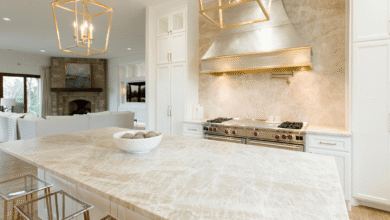
The Ultimate Guide to Caring for Porcelain Worktops
Introduction
Investing in porcelain worktops means choosing a surface that combines style, durability, and sophistication. Once installed, you’ll naturally want to keep it looking as flawless as the day it arrived. The good news? Porcelain is famously low maintenance but “low” doesn’t mean “no” maintenance. With a few simple habits and basic cleaning practices, you can easily preserve its pristine beauty for decades.
In this comprehensive care guide, we’ll explore how to handle daily cleaning, deal with occasional mishaps, and understand what to avoid. With these straightforward steps, your porcelain worktop will remain the showpiece of your kitchen or bathroom for years to come.
Daily Care: Effortless Cleaning for Everyday Use
One of the biggest advantages of porcelain worktops is how easy they are to clean. Thanks to their non-porous, vitrified surface, liquids and bacteria can’t penetrate the material meaning stains and odours don’t stand a chance.
For everyday cleaning, you only need a soft cloth or sponge, warm water, and a mild, pH-neutral detergent. Simply wipe the surface to remove crumbs, smudges, or spills. There’s no need for harsh chemicals or specialized cleaning products — in fact, these can damage the finish over time.
Unlike granite or marble, porcelain never needs sealing or waxing, as its non-porous nature keeps it naturally resistant to stains and moisture. This makes it ideal for busy families, frequent cooks, or anyone who loves the beauty of natural stone without the heavy upkeep.
Dealing with Stains and Spills: Quick Fixes That Work
While porcelain worktops are highly resistant to staining, the best rule of thumb is simple don’t let spills linger. Most marks from common kitchen substances like coffee, red wine, olive oil, or fruit juice can be wiped away immediately with your regular cleaning solution.
For more stubborn spots such as dried paint, gum, or hardened food — start with gentle scraping using a plastic scraper or putty knife to lift off any buildup. Porcelain’s impressive scratch resistance means that light scraping won’t damage the surface if done carefully.
Next, apply a mild porcelain cleaner or a paste made from baking soda and water. Let it sit for a few minutes to loosen the residue, then scrub gently with a soft brush or non-abrasive pad before rinsing thoroughly.
If you’re cleaning up after renovation work and encounter dried cement or mortar, an alkaline cleaner designed for porcelain surfaces is the best solution. Avoid using steel wool or abrasive scouring pads, as these can leave micro-scratches or dull the glossy finish.
What to Avoid: Protecting Your Investment
While porcelain worktops are extremely durable, a few precautions will help ensure they stay flawless for decades.
- Don’t cut directly on the surface.
Porcelain is highly scratch-resistant, but it isn’t completely scratch-proof. Using knives directly on the surface can leave faint marks and will quickly dull your blades. Always use a chopping board to protect both the surface and your kitchen tools. - Avoid sudden extreme temperature changes.
Porcelain easily withstands high heat, but rapid temperature shifts known as thermal shockcan cause stress cracks. For example, moving a scorching hot pan straight from the oven to a cold countertop can be risky. Use trivets or heat pads to be safe. - Be cautious with impacts.
Although porcelain is strong, its slim profile can make sharp edges vulnerable to heavy blows. Take care not to drop heavy cookware or appliances directly on the edges or corners to prevent chips or cracks.
By keeping these simple guidelines in mind, you’ll protect your worktop’s structure and shine for the long term.
Long-Term Preservation: Keeping It Beautiful for Life
With proper care, porcelain worktops require no ongoing treatments, sealing, or expensive professional polishing. The colour and pattern run through the entire slab, so fading, staining, or surface wear are practically nonexistent.
Should minor scratches or dull spots appear after years of use, a professional fabricator can usually restore the original finish with a light polish. For small chips or edge damage, repair specialists can use colour-matched epoxy resin to make the fix nearly invisible.
Porcelain’s inherent durability and low maintenance make it perfectly suited to modern lifestyles. Whether in a family kitchen or a high-end bathroom, it delivers timeless appeal without the constant upkeep that natural stone demands.
Conclusion
Caring for porcelain worktops couldn’t be simpler and that’s one of the many reasons they’re such a popular choice for today’s homes. With just a quick daily wipe, prompt attention to spills, and a few protective habits, you can keep your surface looking immaculate for decades.
Porcelain doesn’t just offer stunning aesthetics; it brings convenience, hygiene, and long-term value to your space. By following these easy care and maintenance tips, you’re not only preserving your investment but ensuring that your porcelain worktop remains a centrepiece of beauty and practicality built to last a lifetime.

